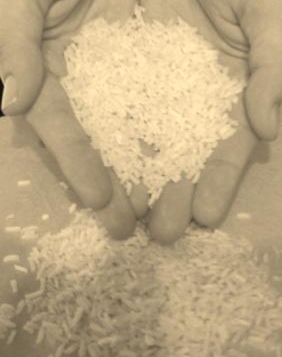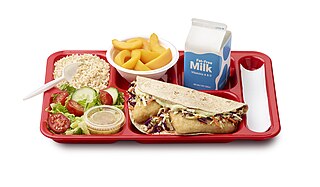
The United States Department of Agriculture (USDA) is an executive department of the United States federal government that aims to meet the needs of commercial farming and livestock food production, promotes agricultural trade and production, works to assure food safety, protects natural resources, fosters rural communities and works to end hunger in the United States and internationally. It is headed by the secretary of agriculture, who reports directly to the president of the United States and is a member of the president's Cabinet. The current secretary is Tom Vilsack, who has served since February 24, 2021.

In the United States, the Supplemental Nutrition Assistance Program (SNAP), formerly known as the Food Stamp Program, is a federal government program that provides food-purchasing assistance for low- and no-income people to help them maintain adequate nutrition and health. It is a federal aid program administered by the U.S. Department of Agriculture (USDA) under the Food and Nutrition Service (FNS), though benefits are distributed by specific departments of U.S. states.

Electronic benefit transfer (EBT) is an electronic system that allows state welfare departments to issue benefits via a magnetically encoded payment card used in the United States. It reached nationwide operations in 2004. The average monthly EBT payout is $230 per participant as of 2022.

The Food and Nutrition Service (FNS) is an agency of the United States Department of Agriculture (USDA). The FNS is the federal agency responsible for administering the nation’s domestic nutrition assistance programs. The service helps to address the issue of hunger in the United States.
The basic needs approach is one of the major approaches to the measurement of absolute poverty in developing countries globally. It works to define the absolute minimum resources necessary for long-term physical well-being, usually in terms of consumption goods. The poverty line is then defined as the amount of income required to satisfy the needs of the people. The "basic needs" approach was introduced by the International Labour Organization's World Employment Conference in 1976. "Perhaps the high point of the WEP was the World Employment Conference of 1976, which proposed the satisfaction of basic human needs as the overriding objective of national and international development policy. The basic needs approach to development was endorsed by governments and workers' and employers' organizations from all over the world. It influenced the programmes and policies of major multilateral and bilateral development agencies, and was the precursor to the human development approach."

The Special Supplemental Nutrition Program for Women, Infants, and Children (WIC) is an American federal assistance program of the Food and Nutrition Service (FNS) of the United States Department of Agriculture (USDA) for healthcare and nutrition of low-income pregnant women, breastfeeding women, and children under the age of five as part of child nutrition programs. Their mission is to be a partner with other services that are key to childhood and family well-being. WIC serves 53% of all infants born in the United States.

Food policy is the area of public policy concerning how food is produced, processed, distributed, purchased, or provided. Food policies are designed to influence the operation of the food and agriculture system balanced with ensuring human health needs. This often includes decision-making around production and processing techniques, marketing, availability, utilization, and consumption of food, in the interest of meeting or furthering social objectives. Food policy can be promulgated on any level, from local to global, and by a government agency, business, or organization. Food policymakers engage in activities such as regulation of food-related industries, establishing eligibility standards for food assistance programs for the poor, ensuring safety of the food supply, food labeling, and even the qualifications of a product to be considered organic.
The Under Secretary for Food, Nutrition, and Consumer Services is a position created within the United States Department of Agriculture in 1993, and is responsible for administrating the department's fifteen nutrition and food security programs and for promoting the dietary guidelines. <7 CFR § 2.19> The food assistance programs have a combined budget of $170.5 billion and include the Food Stamp Program, the Special Supplemental Nutrition Program for Women, Infants and Children, the National School Lunch and School Breakfast Programs, and the Commodity Distribution Programs. In addition, the Undersecretary oversees the Center for Nutrition Policy and Promotion, which leads the development of dietary guidelines and which promotes the guidelines through the Food Guide Pyramid (MyPyramid.gov).
Nutrition Assistance for Puerto Rico (NAP) —Spanish: Programa de Asistencia Nutricional (PAN) popularly known in Puerto Rico as Cupones — is a federal assistance nutritional program provided by the United States Department of Agriculture (USDA) solely to Puerto Rico. In 2021, over $2 billion USD was appropriated as a block grant for NAP to assist over 1 million impoverished residents of Puerto Rico. It is based on, though not part of, the USDA's national Supplemental Nutrition Assistance Program (SNAP) which in 2018 provided $64 billion in nutritional assistance to 42 million people in the 50 U.S. states, D.C., Guam and the US Virgin Islands.
The Child and Adult Care Food Program (CACFP) is a type of United States federal assistance provided by the Food and Nutrition Service (FNS) of the United States Department of Agriculture (USDA) to states in order to provide a daily subsidized food service for an estimated 3.3 million children and 120,000 elderly or mentally or physically impaired adults in non-residential, day-care settings. It is a branch within the Policy and Program Development Division of the Child nutrition programs, along with the School Programs Branch, which runs the National School Lunch Program. The program is commonly referred to as the Child Care, Child Care Food, Adult Care, or Adult Care Food Program, and is often operating in conjunction with other child and adult day-care programs, such as the Head Start. Its federal identification number, or CFDA number, is 10.558. Section 17 of the National School Lunch Act, and USDA issues the program regulations under 7 CFR part 226.

A food stamp challenge or SNAP challenge is a trend in the United States popularized by politicians, religious groups, community activists and food pantries, in which a family of means chooses to purchase food using only the monetary equivalent of what a family that size would receive in the US federal government Supplemental Nutrition Assistance Program (SNAP), colloquially called food stamps. In 2015, this amounted to US$194.00 per person per month, or $6.37 per day.
The Emergency Food Assistance Program (TEFAP) is a program that evolved out of surplus commodity donation efforts begun by the USDA in late 1981 to dispose of surplus foods held by the Commodity Credit Corporation (CCC). This program was explicitly authorized by the Congress in 1983 when funding was provided to assist states with the costs involved in storing and distributing the commodities. The program originally was entitled the Temporary Emergency Food Assistance Program when authorized under the Temporary Emergency Food Assistance Act of 1983. The program was renamed to The Emergency Food Assistance Program (TEFAP) in 1990.
Harvard Law defines poverty law as, "the legal statutes, regulations and cases that apply particularly to the financially poor in his or her day to day life". In a commonsense understanding and in practice, the goal of poverty law is to protect the disadvantaged poor from unfair treatment by the law. Poverty law often overlaps with federal benefits and welfare policies. Pertinent federal government benefits include Medicaid; cash public assistance ; and the Supplemental Nutrition Assistance Program (SNAP) program, previously known as the food stamps program. Poverty law frequently involves questions of administrative law, civil rights law, constitutional law, employment law, and health law.
Nutrition education is a combination of learning experiences designed to teach individuals or groups about the principles of a balanced diet, the importance of various nutrients, how to make healthy food choices, and how both dietary and exercise habits can affect overall well-being. It includes a combination of educational strategies, accompanied by environmental supports, designed to facilitate voluntary adoption of food choices and other nutrition-related behaviors conducive to well-being. Nutrition education is delivered through multiple venues and involves activities at the individual, community, and policy levels. Nutrition Education also critically looks at issues such as food security, food literacy, and food sustainability.
The New York City Coalition Against Hunger (NYCCAH) is a nonprofit organization, which aims to “enact innovative solutions to help society move ‘beyond the soup kitchen’ to ensure economic and food self-sufficiency for all Americans”. NYCCAH works collaboratively with local, state, and national legislatures as well as New York residents and community associations. In contrast to other organizations, NYCCAH generally does not distribute food but rather concerns itself with providing technical assistance to groups which do while simultaneously affecting hunger policy at a more macro-urban scale.

The Farmers' Market Nutrition Program (FMNP) is a federal assistance program in the United States associated with the Special Supplemental Nutrition Program for Women, Infants and Children that provides fresh, unprepared, locally grown fruits and vegetables and nutrition education to WIC participants. Women, infants and children that have been certified to receive WIC program benefits or who are on a waiting list for WIC certification are eligible to participate in the FMNP.

In the United States, school meals are provided either at no cost or at a government-subsidized price, to students from low-income families. These free or subsidized meals have the potential to increase household food security, which can improve children's health and expand their educational opportunities. A study of a free school meal program in the United States found that providing free meals to elementary and middle school children in areas characterized by high food insecurity led to increased school discipline among the students.

CalFresh is the California implementation of the federal Supplemental Nutrition Assistance Program (SNAP), formerly known as the Food Stamp program, which provides financial assistance for purchasing food to low-income California residents.
The Commodity Supplemental Food Program (CSFP) provides supplementary United States Department of Agriculture (USDA) food packages to the low-income elderly of at least 60 years of age. It is one of the fifteen federally-funded nutrition assistance programs of the Food and Nutrition Service (FNS), a USDA agency. The CSFP currently serves about 600,000 low‐income people every month.
The Food Justice Movement is a grassroots initiative which emerged in response to food insecurity and economic pressures that prevent access to healthy, nutritious, and culturally appropriate foods. The food justice movement moves beyond increasing food availability and works to address the root cause of unequal access to adequate nutrition. Like other Environmental Justice initiatives, the Food Justice Movement advocates for rights-based solutions that identify the underlying human rights that allow individuals to achieve adequate food security and nutrition. This differs from policy-based solutions that focus on food availability and affordability by increasing food production or lowering the cost of food.








